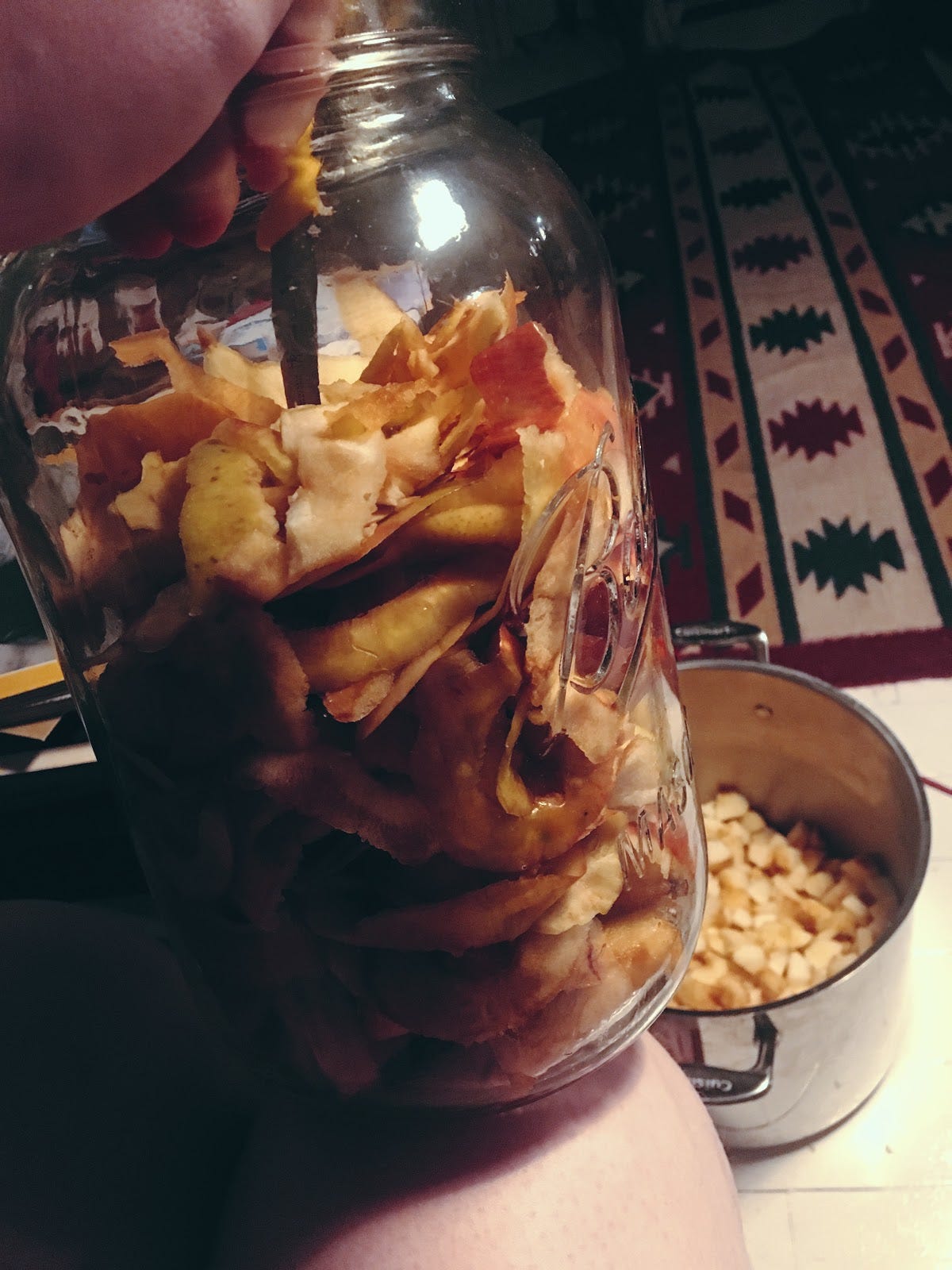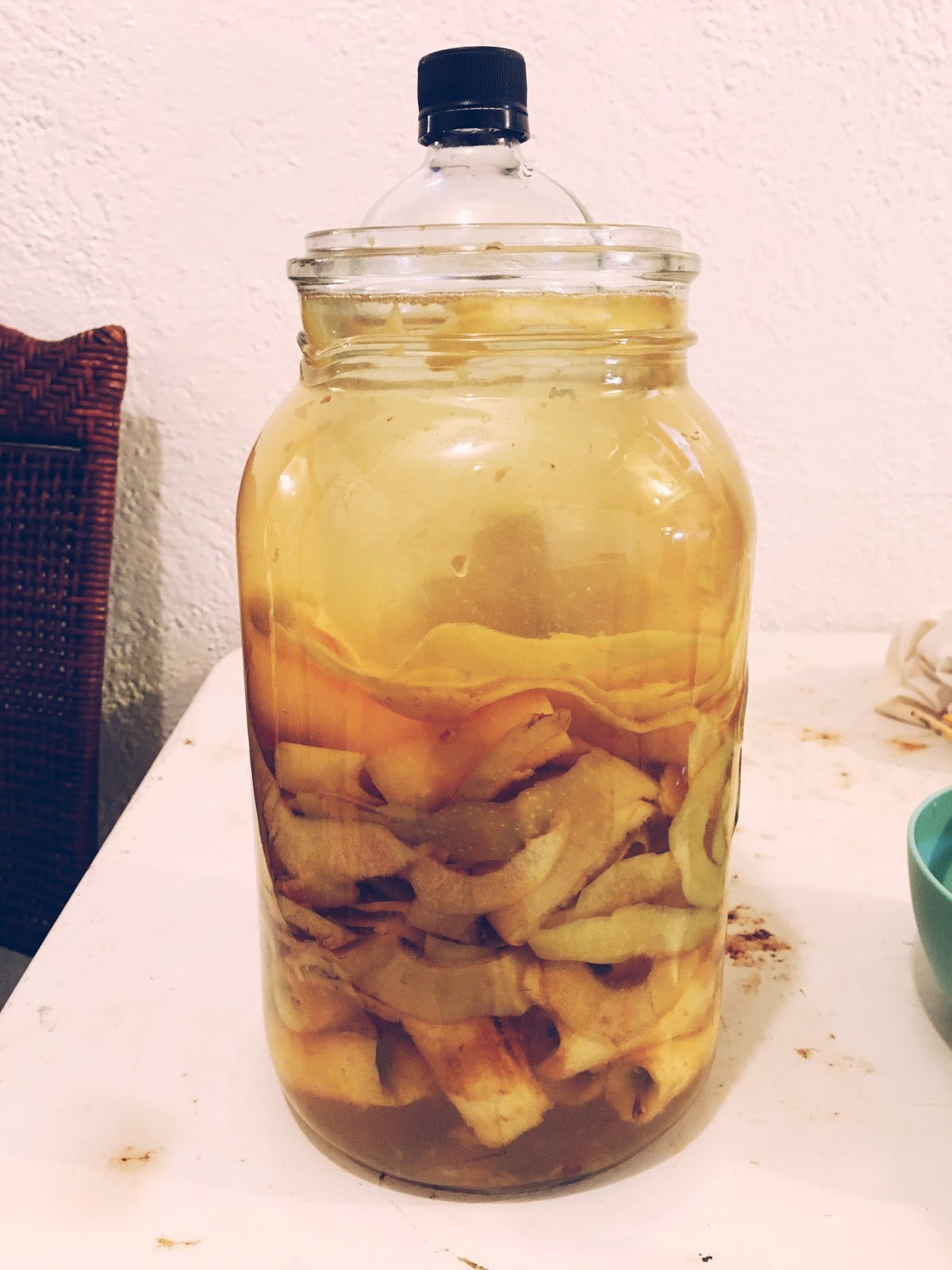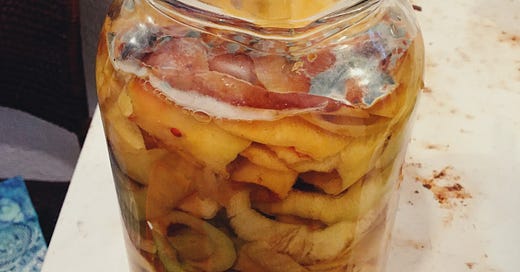You’re probably not using enough vinegar in your cooking. Along with salt and maybe sometimes sugar, it’s one of the things that is so often left behind that would otherwise lend richness and depth of flavor to a meal but is generally forgotten as a standby ingredient on the counter. For most home cooks, unless their SEO Google result recipe tells them otherwise, vinegar is for salad dressings and marinades.
Vinegar is probably as old at least as alcohol, likely dating back to the Ancient Egyptian empires when beers made from grain would get too much oxygen, changing the sugars that became alcohol into acetic acid.
Vinegar, specifically homemade, is more versatile than it’s given credit for. I’m not talking about the beauty craze of literally bathing in apple cider vinegar, or taking a shot of it in the morning although those are things I think are kinda cool. I specifically mean the process of tasting your food for acidity in addition to salt. Most vegetables, even high acid ones like tomatoes, receive vinegar well either as an enhancer or again, in the case of tomatoes, as a stabilizer.
You can use vinegar to deglaze your pan, and return the caramelized sugars released by meats and vegetables back to them. You should splash some into your soups, add them to your braises, sprinkle them onto starchy grains and use them in cocktails. Always use them when you build a sauce.
It’s a substance that comes from a process of rotting. We have to break down most of our foods before we eat them, that’s what cooking is. Until relatively recently, in order to combat food waste and use all of the things available to us, home cooks frequently had crocks and bottles of rotting foods that, given time, could be rendered usable again. Probably because it’s a little gross.
I made apple cider vinegar a few times in college with straight up apple cider from the cider mill outside of town. Since, I haven’t lived anywhere with such luxury but adding some yeast to a juice and forgetting about it until it tastes good is pretty classic. In the past several years, I’ve been captured by my own neuroses regarding food waste, especially food waste of fruits and vegetables grown nearby where I am. I see a value in using everything to its maximum capability.
So I’ve been making apple scrap vinegar instead. Last year, I made a vinegar with the leftovers from a Halloween spiced cider. The flavor of the spices transferred to the vinegar and enhanced jams, pies and cocktails. It’s even pretty good watered down and warm with a little honey in it, frankly.

Right now I’m in the process of making regular apple scrap vinegar. In September, at the beginning of horseradish season, I put together what’s called a fire cider from the rest of the plain apple scrap vinegar I made last year.
Invented by one Rosemary Gladstar, fire cider is basically a horseradish, herb, citrus and spice infused vinegar that is supposed to work like a tonic. Mostly it’s just something you can add to soups, salads or whatever but you can also just down a shot when you’re feeling unwell and stare into the face of God. I added golden cayenne and green chiles to mine this year and I’ll include the recipe below.
But for now, I’ve got a gallon sized glass jar in my basement that I go look at every few days to make sure it’s not getting creepy. And it can certainly get creepy! In basically any fermentation project, you want to control the amount of oxygen, yeast and bacteria that’s interacting with your fermenting materials.

A week ago I went to my basement to check on some sauerkraut and found that some of my apple scraps rose to the top of the water they’re decomposing in and covered everything in a weird webby mold. I just removed the offending subjects, skimmed everything off the top, wiped the exposed internal glass down with white vinegar and placed a glass bottle filled with water into the scraps to keep them weighted down.

I used 18 apples, and I suggest that you find some locally at a farmer’s market or from a roadside fruit stand but now is the time. With the pulp I made a basic unsweetened applesauce and then packed the rest of it into a clean glass jar. You can use a fermentation lid or a burper but I just covered it with a couple layers of cotton kitchen cloth to control the flow of oxygen and keep out pests.
Vinegar is made by sugars in fruits and juices fermenting into ethyl alcohol and then that alcohol goes through a partial oxidation that forms acetaldehyde. Then, the bacteria and wild yeasts convert that to acetic acid. Adding a splash of vinegar from the year before or Bragg’s ACV “with the mother” to the mix will also give the bacteria a boost to replicate a similar friendly biome.
So if you’re using apple scraps you want to add sugar. This accelerates the process by giving the bacteria something to start eating. You don’t want to add too much because it will take forever, just a couple tablespoons per gallon of water. This year I used honey which, given it’s antimicrobial nature, will take substantially longer to process. But whatever I wanted to give it a shot.
Once the color of the liquid starts turning more yellow and smelling like vinegar, I’ll routinely taste it or even test the acid content until I determine it’s usable. Then it gets filtered into sterilized old Bragg’s ACV bottles and gets stored in a cabinet or it sits by my stove for the rest of the year.
Ultimately, making vinegar is not so much an exercise of patience as it is of memory. That’s one of the blessings of fermentation, you can kinda just let things go and include reminders in your phone for the stuff you have living and decomposing in your basement or in the back of a cabinet.
APPLE SCRAP VINEGAR
Tools
1 gallon jar, cleaned with hot soap and water and dry. Do NOT use metal for this.
Sterilized glass bottle slim enough to fit in the mouth of the jar filled with water and capped
Apple corer and peeler, whatever method
Kitchen cloth or tight woven cheesecloth, folded over several times to cover the mouth of the jar
Rubber band
Sieve
Funnel
Glass bottles
Ingredients
18 apples (or more! Like up to 24 even.)
1 gallon filtered or distilled water
2 T sugar or honey
Optional: splash of ACV “with the mother”
Instructions
Core and peel your 18 apples. Layer them into your vessel, cores on the bottom and peels on top to keep the cores weighed down. Pack in your fruit scraps so that they hold tight in the bottom half of the jar.
Stir your honey or sugar into a pint of the water to dissolve. Pour this over the scraps and follow with remaining water leaving several inches at the top. Making sure that the scraps hold down in place. Splash in your ACV and place your glass bottle in to weight everything down.
Cover with a folded cloth and rubber band and place it in a stable temperature, dark space in your house. Wait for a while, like two weeks maybe but that’s a little early. Check in on it every few days to see if any fruit floated up, but eventually it will absorb the water and weigh down. Watch for changes in the color as it becomes more amber over time. Take note of the smell, it might smell a little boozy for a bit but once you start getting the acidity in the scent, you’ll know you’re coming along.
Once it smells and tastes of vinegar, strain the contents through a cheesecloth and a sieve to remove any floating pulp. Funnel it into bottles and keep it in a cool dark place until you’re ready to use it.

GREEN CHILE FIRE CIDER (to Cure What Ails You)
Tools
1 half gallon jar and lid, cleaned with hot soap and water and dried
Grater or food processor
Cutting board and knife
Parchment paper
Sieve
Funnel
Glass bottles, cleaned with hot soap and water and dried
Ingredients
1 half gallon of homemade apple scrap vinegar
½ cup fresh grated horseradish, found in grocery stores in early fall
4 fresh roasted green chiles, skinned, seeded and diced
3 jalapenos, habaneros or golden cayenne peppers, sliced
1 onion, small dice
8-10 cloves of garlic, minced
3 inches ginger, sliced
1 bunch fresh thyme, smack it with a rolling pin a few times
1 T cumin seeds, crushed
2 tsp turmeric
Juice and zest of 2 lemons
Steps
Prepare all your ingredients and throw them into the jar.
Pour the apple cider vinegar over the top of the ingredients, leaving about an inch of space at the head of the jar.
Place the parchment paper between the metal jar lid and the mouth of the jar, twist on the ring until it is very tight.
Store it in a temperature stable dark place in your house and shake it every day.
After four weeks, strain out the pulp and squeeze to get as much liquid as you can.
Funnel it into your bottles (i use leftover booze bottles with a cork, but hingetop bottles are great too).
Drink it when you feel like shit or use it for whatever you want. It’s so good.
NOTE:
All the mystical witch ladies online also love adding raw local honey at the end before you bottle it. I don’t think that tastes super good with the earthiness of the chiles and the cumin together but if that sounds good to you, go nuts. I’m not your mom.



This is the best example of writing a story about food with a recipe. Thank you, I really enjoyed this.